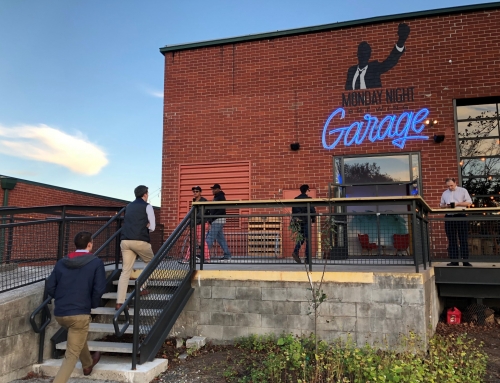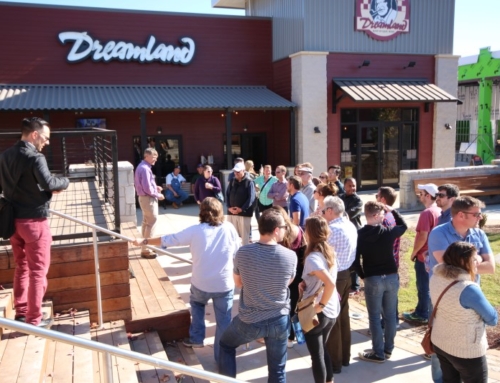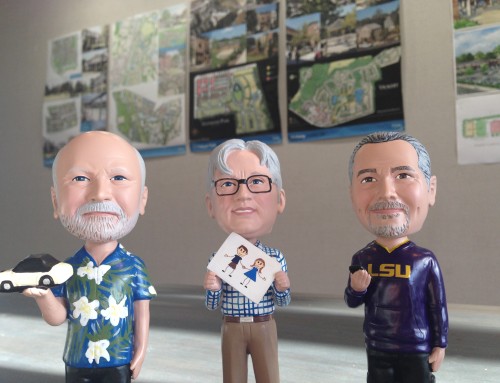Urban Retail by TSW Featured in Georgia Trend Magazine
The October edition of Georgia Trend magazine included an article on new urban retail that featured three of TSW’s projects– Woodstock, Vickery, and Edgewood Retail District.
Rethinking Retail: Walk This Way
Shopping is increasingly pedestrian-oriented as enclosed malls are being eclipsed by mixed-use communities and open-air lifestyle centers, with more greenspace and less pavement.
Georgia Trend
Katheryn Hayes Tucker
Published October 2007Bonnie Flood is a new kind of Georgia retailer. Once the owner of a chain of women’s clothing stores in suburban Cobb County, she moved to the Big Canoe community north of Atlanta to hike in the woods and pursue her real passion – painting. After a few years she and her husband decided they’d like to be nearer to people and services, so they could go shopping without driving. “We wanted to take a walk and get a cup of coffee or an ice cream,” she says.
So Bonnie and Cliff Flood found a new home in Vickery, the new Hedgewood Properties mixed use community in Forsyth County that has won accolades for its walkable blend of homes, parks, paths and shops. The Floods live in a four-level townhouse from which they can walk to Bonnie’s new business, the Bonnie Flood Gallery in the heart of Vickery Village – the commercial district that the neighborhood wraps around. They can also walk to restaurants owned by other members of the family. Bonnie’s daughter, Chari Harlan, opened Sidney’s Pizza and Pasta, and her son, Michael Brosius, has opened Cinco Mexican Cantina.
The Bonnie Flood Gallery displays and sells an array of colorful works by Flood herself and a score of others. It’s a one-of-a kind shopping experience.
As this development and a variety of other new developments indicate, shopping in Georgia is changing more dramatically that it has since Lenox Square opened in 1959. The once dominant regional enclosed shopping malls are being eclipsed by pedestrian oriented, walkable centers – often mixed use, often open air and always user-friendly.
“I believe the large shopping mall we are used to seeing is less attractive than it used to be,” says Jim Durrett, executive director of the Atlanta-based nonprofit Livable Communities Coalition. “There is a desire for a more walkable, pleasant, even outdoor shopping mall. The big regional mall is losing ground to more of a lifestyle center.”
The term lifestyle center is very much in vogue. Durrett says such a place is not necessarily mixed use, but designed to create more of a main street experience with walking paths, public space and trees, landscaping and gathering areas between parking areas. The big difference is the decline of the dominance of the automobile. Cars are there, sure; but there’s a lot less pavement.
The design is being driven by practical forces: traffic congestion, gasoline prices and the increasing appeal of new urbanism. “A lot of people realize now the importance of having housing and retail opportunities closer together,” Durrett says. “When the pain of changing is less than the pain of staying the same, we change.”
So the pendulum is swinging in the opposite direction of the planning wisdom that characterized the second half of the 20th century, when the modus operandi was to create nodes of commercial development with residential subdivisions sprawling in every direction.
Now across Georgia and the rest of the country, developers are putting together villages to help their projects succeed. Retailers are partnering with residential and office specialists to create mixed-use, village-like centers inspired by the new urbanism movement and not at all like the old shopping malls that sprung up in every direction and let other developments come sprawl around them.
“We’re working very hard to create community,” says Cheri Morris, CEO of Hedgewood Commercial Properties, which developed Vickery Village in partnership with Hedge-wood Properties, the home builder. That means actively seeking a mix of tenants to support the residents – a doctor, a dentist, a dry cleaner, a salon as well as various shops and galleries.
But civic components are just as important. The community has its own YMCA and a shop called Wild Bird Center, which supports a bird club. “We’ve really tried to create a true village that would build a lifestyle,” Morris says. “If you live in Vickery, you can walk to many things you need in your life.”
Ironically, Vickery Village has already begun attracting visitors from other communities. They can drive in for the day, park in the not-so-prominent but plentiful spaces and walk to shops and restaurants.
“Vickery is very much a destination,” Morris says. “We knew it would attract people.”
It’s also attracting emulation elsewhere. Hedgewood is already at work on a similar project, Woodstock Downtown, which includes housing, offices and retail around the town’s main street, embracing and upgrading some historic sites and rebuilding on others. The Woodstock retail district is scheduled to open this year in time for Christmas shopping. Other developers are building mixed-use projects around Metro Atlanta. Even in smaller towns, housing is popping up near retail or just off downtown streets.
The Merits Of Mixed Use
Georgia’s biggest and best-known mixed-use project is the massive city within a city in midtown – Atlantic Station. The $2 billion development broke ground and news across the country with its innovative blend of uses, its village atmosphere and its attention to environmental concerns. Even though it will be several years before it’s completely finished, Atlantic Station is open to shoppers and residents, and it’s already being replicated on a smaller scale around Metro Atlanta and even around the state.One of the biggest players is the Florida-based Sembler Company, which has half a dozen mixed-use projects in various stages of development in the Atlanta area, including one proposed for a 106-acre site in DeKalb County, where plans are already generating controversy.
“We’re the largest retail and mixed-use developer in Georgia,” says Jeff Fuqua, president of the Sembler Company, who lives in Atlanta’s Virginia-Highland neighborhood. “We actually believe we can do this high-density, mixed-use development anywhere. We’re looking for a deal in Savannah now. We’re working on a site in Macon,” he says. “Everyone is looking for a better-looking, walkable, more interesting project – not just a big parking lot.”
The formula, Fuqua says, is to “bring in all the experts in their field.” He adds, “I think we’re leading the way and pushing the limits with every project.”
Sembler has finished building its Edgewood retail district near Little Five Points in Atlanta, but is still at work on two adjacent residential buildings. The project boasts such big-name retailers as Target, Kroger, Barnes & Noble, Best Buy, Lowe’s, Bed, Bath and Beyond. Total investment in Sembler’s Edgewood project is $147 million, Fuqua says.
One of the significant benefits of such a project is the synergy. Sembler is proud of the like-minded development its projects have sparked in areas nearby. For example, he says, once Sembler began work on its Lindbergh Plaza mixed-use redevelopment in Buckhead, eight other developers went to work within a one-mile radius. As a result, the entire area has been revitalized. The so-called Transit Oriented Develop-ment surrounds the Lindbergh MARTA station.
Location near rapid transit is important to many of these new urban style developments, but it’s not the only critical factor. Take, for example, Perimeter Place just north of I-285. The nearby Dunwoody MARTA station is a plus, but Fuqua says the lure of living and working in an area so rich with office buildings and shopping centers is even more important. The Sembler development there includes a 27-story high rise condo building and a six-story apartment building all adjacent to Perimeter Mall. “You have that urban feel but it’s not real urban. It’s in-between,” he says. “Most people who bought or rent work right there.”
Plenty of other developers have targeted the Perimeter Mall and Dunwoody MARTA Station area as well, and the traffic proves it. Another major mixed-use project called High Street was announced in May by the Boston-based GID Urban Development Group, which plans 20 buildings, ranging from four to 20 stories with 400,000 square feet of retail, the same amount in offices, along with 3,000 residential units and 400 hotel rooms. Plans call for a grid of streets with sidewalks to create a livable, pedestrian community center. Construction is to start in 2009, with the first openings in 2011.
This type of transit oriented development is “exactly what we need to see more of,” Durrett says.
Close by is another perimeter area project Sembler began work on this year, a $125 million mixed-use redevelopment of the Prado in Sandy Springs. The 34-year-old shopping center occupies a 27-acre-site on Roswell Road at I-285. The old tenants’ space will remain, but a four-level redevelopment will open next year with Home Depot, Publix, Target and 345,000 square feet of new retail. In addition, Sembler has purchased adjacent apartment complexes to renovate as part of the project.
Also late next year, Sembler plans to open Brookhaven Place, a mixed-use development on 50 acres at the intersection of Peachtree Industrial and Cross Keys Drive with 600,000 square feet of retail, 150,000 square feet of office space and 1,560 residential units. The company is referring to this $600 million project as an “open-air urban village.”
What would be the biggest Sembler urban village, The Park at Briarcliff, is proposed for the intersection of Briarcliff and North Druid Hills roads in north central DeKalb County. This project, which Sembler has been presenting to county officials and to residents at a series of meetings, has generated concerns about additional traffic in an already-congested area that includes several well-established neighborhoods. The Park would include 1.5 million square feet of retail, 3,700 high-density residential units vertically integrated with retail, a half-million square feet of office space and two hotels. The company describes the Briarcliff project as “a state-of-the art urban, high-density redevelopment that exemplifies smart growth and prevents sprawl.”
Sprawl has become an inflammatory word, often used by environmental activists to condemn developments. Most criticized perhaps in the Atlanta area was the Mall of Georgia, which opened in 1999 at the fork formed by the split of Interstate 985 off I-85 near Buford in Gwinnett County. Because of its distance from Atlanta and its location in a relatively rural area, it was called a sprawl magnet. And just as predicted when the mall opened, the sprawl and the traffic have grown along with the revenues.
But even that monumental mall has a village layout for shops on its north side and an outdoor gathering space with a small amphitheater and a big walk-in fountain where children splash in the summer. And in the retail that has grown around it, developers have experimented with mixed uses. Six years ago, North American Properties completed Marketplace at Mill Creek just across Highway 20 from the mall, adding apartments, three hotels and specialty retailers to the area. “Mixed use has been in the front of our minds for years,” says Tonya Creekmore, vice president of leasing for North American Properties in Atlanta.
Rescue Efforts
Mixing uses isn’t the only way retailers have begun to show their creativity and satisfy environmental concerns. Atlantic Station was built on a brownfield, an old steel mill site that had to be cleaned up before any building could be done. North American rescued a similar piece of land in Acworth, a small town north of Atlanta in Cobb County, with Lakeside MarketPlace, a $45 million open-air shopping center.The land was formerly a dumping ground with a flea market, cheap motel and truck stop left over from the days when Highway 41 was a main route into Atlanta. The fire marshal condemned the site because of methane gas and underground fires.
It definitely took a village to clean up that site. The county, the city, the school board, the community, the fire department, the Georgia Department of Environ-mental Protection and the giant developer joined forces, and North American put a shopping mall there – anchored by a SuperTarget. Lakeside MarketPlace turned a problem into an asset, says Creekmore, who adds that addressing such challenges is part of North American’s niche.
This year, North American plans to open the redeveloped Merchant’s Festival, an aging shopping center at the intersection of Johnson’s Ferry Road and Roswell Road (State Route 120) in affluent East Cobb County. To make the site work for its anchor tenant, Target, North American had to regrade the land and add a two-story parking deck.
“It’s an out-of-the box innovative design to accommodate Target in a market where there wasn’t enough land to site them,” Creekmore says. “It’s an infill development that also updates a shopping center that was not consistent with the architecture of the area.”
Near Merchant’s Festival is The Avenue East Cobb, part of a string of upscale open-air shopping centers – seven in four states – developed by Cousins Properties Inc. since 1998. While these centers don’t mix uses, they do depart dramatically from the traditional closed shopping malls. They provide a common gathering place and a walking environment to such retailers as Amercan Eagle Outfitters, Ann Taylor, Banana Republic, Pottery Barn, Talbots and Victoria’s Secret. The company describes them as “pedestrian friendly centers.”
The movement toward pedestrian friendliness extends to the state’s far northern border. The Melbourn Group has opened one mixed-use development in Dalton – Ham-mond Creek, just off the bypass – and is at work on another in Fort Oglethorpe – Battlefield Crossing on Battlefield Parkway – just outside Chattanooga.
Both the Dalton and Fort Oglethorpe developments are putting condos and town homes near retail and office space, with common areas and paths in between. “The mode we’re in is not your typical North Georgia development – straight road, put in as many as you can,” says Kevin Wright, a partner with the Melbourn Group. “We’re working to do quality development with land use planning and architectural controls.”
Wright says his group is also working in the community to bring about better land use planning in North Georgia – no easy task in an area where many residents oppose any kind of restriction on how they use their property. Land use planning might not sound like something on the top of a to-do list for a retail developer, but it’s at the heart of the mixed-use trend.
“The beauty of mixed use is not only walkability, but very efficient use of the land,” says Morris of Hedgewood Commercial Properties. “You can use the same parking, the same garden. You can have a substantial and important piece of greenspace.”





